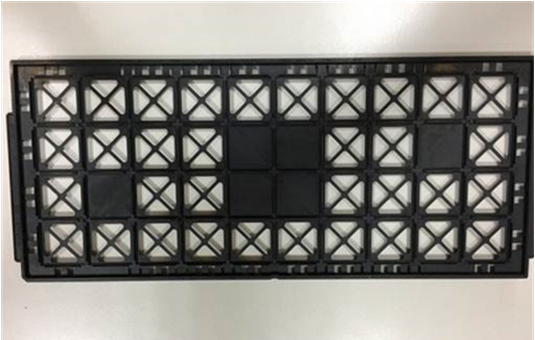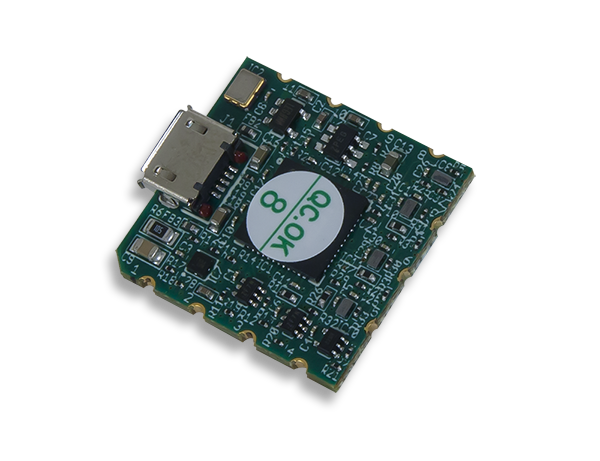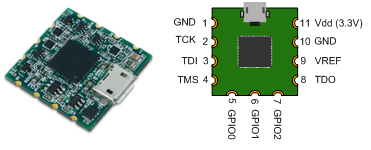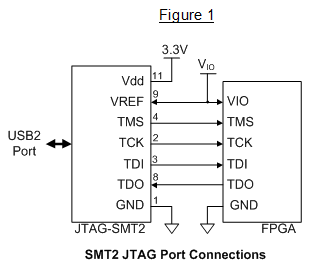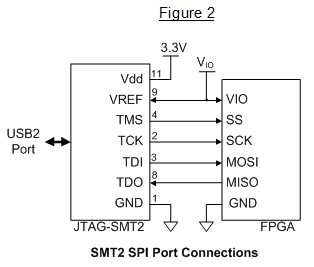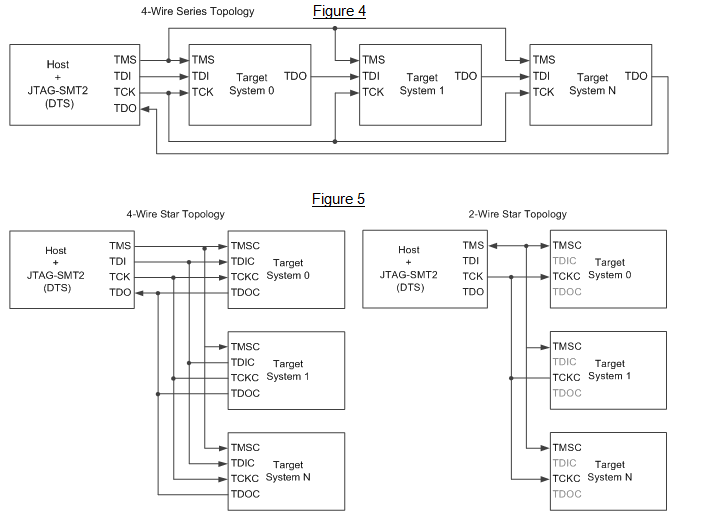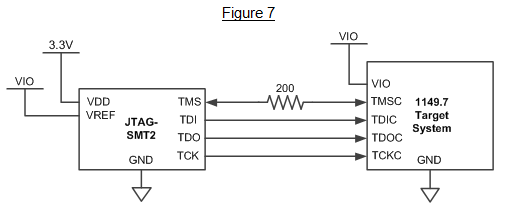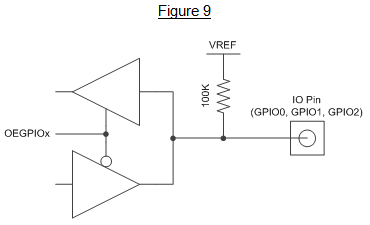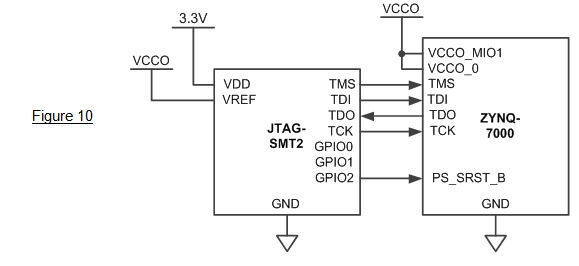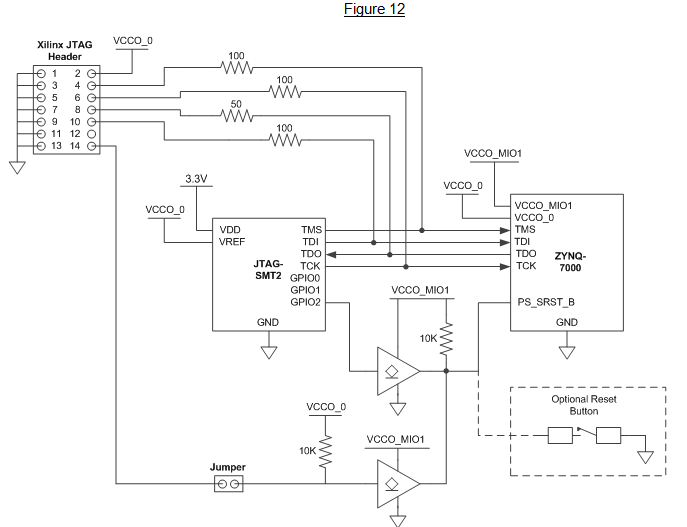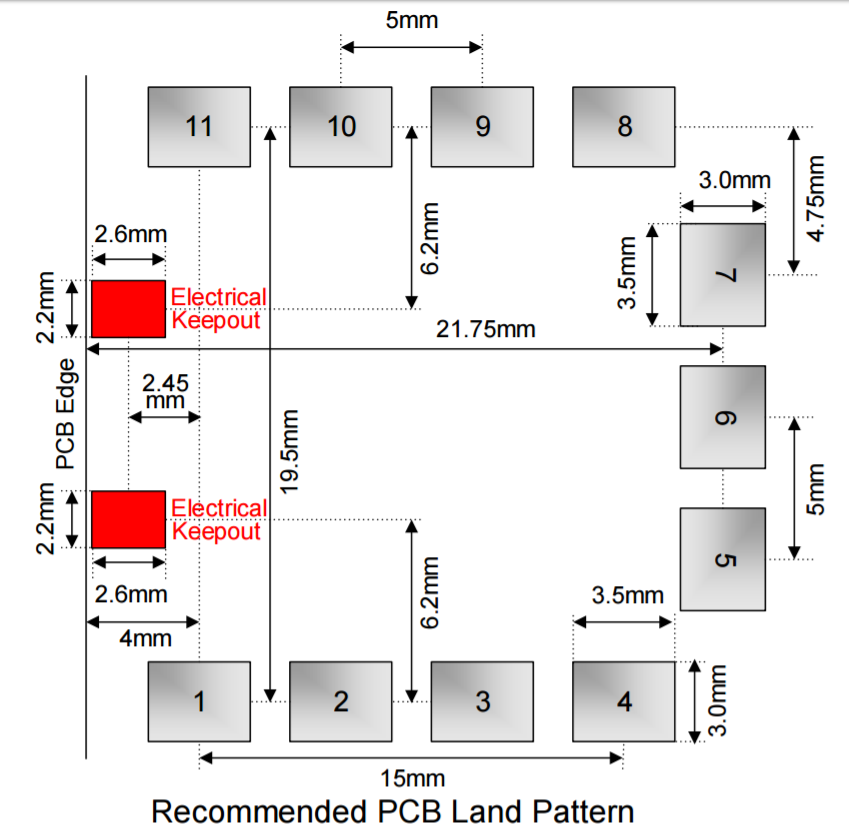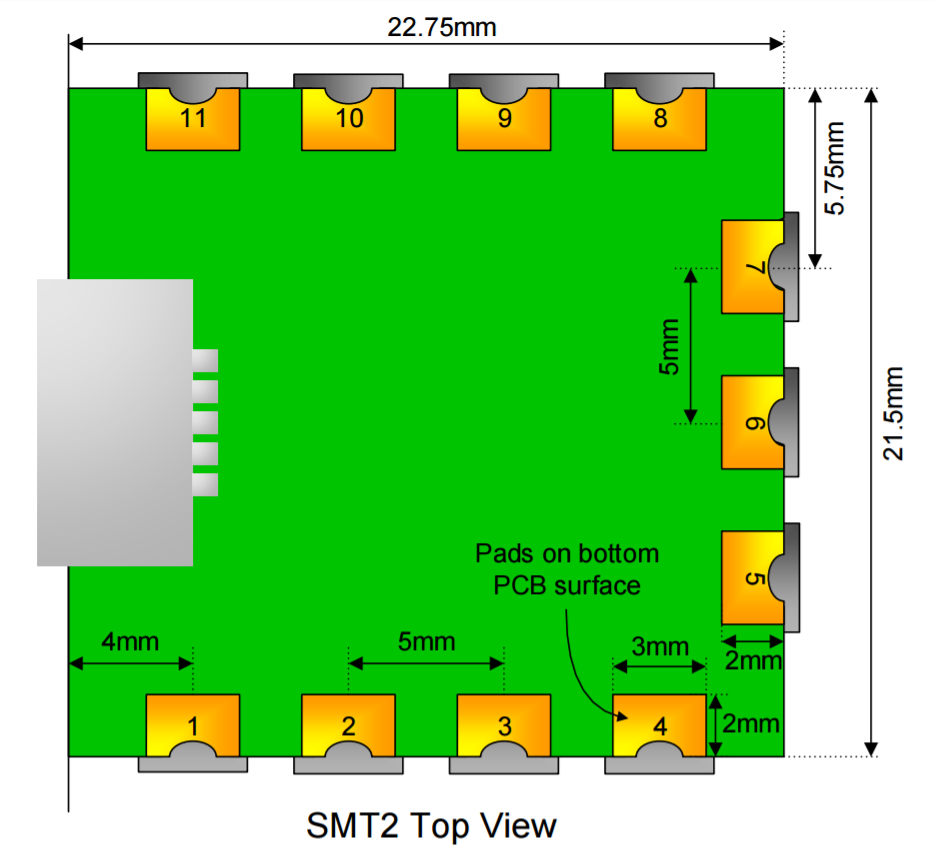JTAG SMT2 Reference Manual
The Joint Test Action Group (JTAG)-SMT2 is a compact, complete and fully self-contained surface-mount programming module for Xilinx field-programmable gate arrays (FPGAs). The module can be accessed directly from all Xilinx tools, including iMPACT, Chipscope, eFuse, Vivado and EDK. Users can load the module directly onto a target board and reflow it like any other component.
Overview
The JTAG-SMT2 uses a 3.3V main power supply and a separate Vref supply to drive the JTAG signals. All JTAG signals use high speed, 24mA, three-state buffers that allow signal voltages from 1.8V to 5V and bus speeds of up to 30MBit/sec. The JTAG bus can be shared with other devices as systems hold JTAG signals at high-impedance, except when actively driven during programming. The SMT2 module is CE certified and fully compliant with EU RoHS and REACH directives. The module uses a standard Type-A to Micro-USB cable available for purchase from Digilent, Inc.
- Small, complete, all-in-one JTAG programming/debugging solution for Xilinx FPGAs
- Compatible with all Xilinx tools
- Compatible with IEEE 1149.7-2009 Class T0 – Class T4 (includes 2-Wire JTAG)
- GPIO pin allows debugging software to reset the processor core of Xilinx’s Zynq platform
- Single 3.3V supply
- Separate Vref drives JTAG signal voltages; Vref can be any voltage between 1.8V and 5V.
- High-Speed USB2 port that can drive JTAG/SPI bus at up to 30Mbit/sec (frequency settable by user)
- SPI programming solution (modes 0 and 2 up to 30Mbit/sec, modes 1 and 3 up to 2Mbit/sec)
- Uses micro-AB USB2 connector
- Small form-factor surface-mount module can be directly loaded on target boards
- A similar circuit is available as a stand-alone programming cable; see Digilent’s JTAG-HS2.
Users can connect JTAG signals directly to the corresponding FPGA signals as shown in Figure 1. For best results, mount the module adjacent to the edge of the host PCB over a ground plane. Although users may run signal traces on top of the host PCB beneath the SMT2, Digilent recommends keeping the area immediately beneath the SMT2 clear. Note: Keep the impedance between the SMT2 and FPGA below 100 Ohms to operate the JTAG at maximum speed. The SMT2 improves upon the SMT1 with the addition of three general purpose IO pins (GPIO0 – GPIO2) and support for interfacing IEEE 1149.7-2009 JTAG targets in both 2 and 4-wire modes.
In addition to supporting JTAG, the JTAG-SMT2 also features eight highly configurable Serial Peripheral Interface (SPI) ports that allow communication with virtually any SPI peripheral. (See figure 2) All eight SPI ports share the same SCK, MOSI, and MISO pins, so users may enable only one port at any given time. The table in figure 3 summarizes the features supported by each port. The HS2 supports SPI modes 0, 1, 2, and 3.
| Figure 3 | ||||||||
| Chip Select Signal | Port Number | SPI Mode | Shift LSB First | Shift MSB First | Selectable SCK Frequency | Max SCK Frequency | Min SCK Frequency | Inter-byte Delay |
| TMS/CS0 | 0 | 0 | Yes | Yes | Yes | 30 MHz | 8 KHz | 0 – 1000 µS |
| 2 | Yes | Yes | Yes | 30 MHz | 8 KHz | 0 – 1000 µS | ||
| 1 | 0 | Yes | Yes | Yes | 2.066 MHz | 485 KHz | 0 – 1000 µS | |
| 1 | Yes | Yes | Yes | 2.066 MHz | 485 KHz | 0 – 1000 µS | ||
| 2 | Yes | Yes | Yes | 2.066 MHz | 485 KHz | 0 – 1000 µS | ||
| 3 | Yes | Yes | Yes | 2.066 MHz | 485 KHz | 0 – 1000 µS | ||
| GPIO0/CS1 | 2 | 0 | Yes | Yes | Yes | 30 MHz | 8 KHz | 0 – 1000 µS |
| 2 | Yes | Yes | Yes | 30 MHz | 8 KHz | 0 – 1000 µS | ||
| 3 | 0 | Yes | Yes | Yes | 2.066 MHz | 485 KHz | 0 – 1000 µS | |
| 1 | Yes | Yes | Yes | 2.066 MHz | 485 KHz | 0 – 1000 µS | ||
| 2 | Yes | Yes | Yes | 2.066 MHz | 485 KHz | 0 – 1000 µS | ||
| 3 | Yes | Yes | Yes | 2.066 MHz | 485 KHz | 0 – 1000 µS | ||
| GPIO1/CS2 | 4 | 0 | Yes | Yes | Yes | 30 MHz | 8 KHz | 0 – 1000 µS |
| 2 | Yes | Yes | Yes | 30 MHz | 8 KHz | 0 – 1000 µS | ||
| 5 | 0 | Yes | Yes | Yes | 2.066 MHz | 485 KHz | 0 – 1000 µS | |
| 1 | Yes | Yes | Yes | 2.066 MHz | 485 KHz | 0 – 1000 µS | ||
| 2 | Yes | Yes | Yes | 2.066 MHz | 485 KHz | 0 – 1000 µS | ||
| 3 | Yes | Yes | Yes | 2.066 MHz | 485 KHz | 0 – 1000 µS | ||
| GPIO2/CS3 | 6 | 0 | Yes | Yes | Yes | 30 MHz | 8 KHz | 0 – 1000 µS |
| 2 | Yes | Yes | Yes | 30 MHz | 8 KHz | 0 – 1000 µS | ||
| 7 | 0 | Yes | Yes | Yes | 2.066 MHz | 485 KHz | 0 – 1000 µS | |
| 1 | Yes | Yes | Yes | 2.066 MHz | 485 KHz | 0 – 1000 µS | ||
| 2 | Yes | Yes | Yes | 2.066 MHz | 485 KHz | 0 – 1000 µS | ||
| 3 | Yes | Yes | Yes | 2.066 MHz | 485 KHz | 0 – 1000 µS | ||
Note: The Xilinx tools expect GPIO2/CS3 to be connected to the SRST_B pin on a Zynq chip. As a result, SPI ports 6 and 7 may not be used for SPI communication if the Xilinx tools are going to be used to communicate with the SMT2.
Software Support
In addition to working seamlessly with all Xilinx tools,which includes iMPACT, Chipscope, eFuse, Vivado and EDK. Digilent’s Adept software and the Adept software development kit (SDK) support the SMT2 module. For added convenience customers may freely downloaded the SDK from Digilent’s website. This Adept software includes a full-featured programming environment and a set of public application programming interfaces (API) that allow user applications to directly drive the JTAG chain.
With the Adept SDK users can create custom applications that will drive JTAG ports on virtually any device. Users may utilize the API’s provided by the SDK to create applications that can drive any SPI device supporting those modes. Please see the Adept SDK reference manual for more information.
IEEE 1149.7-2009 Compatibility
The JTAG-HS2 supports several scan formats including the JScan0-JScan3, MScan, and OScan0 - OScan7. It is capable of communicating in 4-wire and 2-wire scan chains that consist of Class T0 – T4 JTAG Target Systems (TS). (See Figure 4 & 5)
The IEEE 1149.7-2009 specification requires any device that functions as a debug and test system (DTS) to provide a pull-up bias on the TMS and TDO pins. In order to meet this requirement, the JTAG-SMT2 features weak pull-ups (100K ohm) on the TMS, TDI, TDO, and TCK signals. Though not required in the specifications, the pull-ups on the TDI and TCK signals ensure that neither signal floats while another source is not driving them. (See figure 6)
Users should place a current limiting resistor between the TMS pin of the SMT2 and the TMSC pin of the TS when using the JTAG-SMT2 to interface with an 1149.7 compatible TS. If a drive conflict occurs, this resistor should prevent damage to components by limiting the amount of current flowing between the pins of each device. A 200ohm resistor will limit the maximum current to 16.5mA when using a 3.3V reference. (See Figure 7 & 8) While this level of resistance should be sufficient for most applications, the value of the resistor may need to be adjusted to meet the requirements of the TS.
In most cases users can avoid a drive conflict by having applications that use the SMT2 communicate with the TS in two wire mode. Use the applications to reconfigure the TS to use the JScan0, JScan1, JScan2, or JScan3 scan format prior to disabling the SMT2’s JTAG port.
The Adept SDK provides an example application that demonstrates how to communicate with a Class T4 TAP controller using the MScan, OScan0, and OScan1 scan formats.
GPIO Pins
The JTAG-SMT2 has three general purpose IO pins (GPIO0, GPIO1, and GPIO2) that are useful for a variety of different applications. Each pin features high speed three-state input and output buffers. At power up the JTAG-SMT2 disables these output buffers and places the signals in a high-impedance state. Each signal remains in a high-impedance state until a host application enables DPIO port 0 and configures the applicable pin as an output. When the host application disables DPIO port 0 all GPIO pins revert to a high-impedance state. Weak pull-ups (100K ohm) ensure that the GPIO signals do not float while not being actively driven. (See figure 9)
When customers use the JTAG-SMT2 to interface the scan chain of Xilinx’s Zynq platform, they should connect the GPIO2 pin of the SMT2 to the Zynq’s PS_SRST_B pin. This connection allows the Xilinx Tools to reset the Zynq’s processor core at various times during debugging operations. Please see the following “Application Examples” section for more information. Note: The Xilinx tools expect GPIO2 to be connected to the SRST_B pin on a Zynq chip. As a result, GPIO2 may not be used as a general purpose I/O if the Xilinx tools are going to be used to communicate with the SMT2. Note: DPIO port 0 can only be used while both JTAG and SPI are disabled.
Application Examples
Example 1: Interfacing a Zynq-7000 when VCCO_0 and VCCO_MIO1 use a common supply
Figure 10 demonstrates how to connect the JTAG-SMT2 to Xilinx’s Zynq-7000 silicon when the same voltage supplies both the VCCO_0 (Programmable Logic Bank 0 Power Supply) and the VCCO_MIO1 (Processor MIO Bank 1 Power Supply). In this case the SMT2 has a 100K pull-up to VREF, which operates at the same voltage as VCCO_MIO1. This similar voltage makes it possible to eliminate the external pull-up that is normally required for the PS_SRST_B pin.
Example 2: Interfacing a Zynq-7000 that uses different voltages for VCCO_0 and VCCO_MIO1
Figure 11 demonstrates how to connect the JTAG-SMT2 to Xilinx’s Zynq-7000 silicon when different voltages supply the VCCO_0 (Programmable Logic Bank 0 Power Supply) and VCCO_MIO1 (Processor MIO Bank 1 Power Supply). If the Zynq’s JTAG pins are operating at a different voltage than the PS_SRST_B, it requires an external buffer to adjust the level of the GPIO2 signal. The example in figure 10 demonstrates the use of an open drain buffer to allow for the possibility of adding a reset button.
Example 3: Interfacing a Zynq-7000 while retaining the Xilinx JTAG Header
Figure 12 below demonstrates how to connect the JTAG-SMT2 to Xilinx’s Zynq-7000 silicon alongside Xilinx’s 14-pin JTAG header. In this example the open drain buffers allow both the SMT2 and Xilinx JTAG Header to drive the PS_SRST_B pin, which may operate a different voltage than the Zynq’s JTAG pins.
Supported Target Devices
The JTAG-SMT2 is capable of targeting the following Xilinx devices:
- Xilinx FPGAs, including UltraScale+
- Xilinx SoCs, MPSoCs, and RFSoCs, including Xilinx Zynq-7000 and Zynq UltraScale+
- Xilinx ACAPs, including Versal
- Xilinx CoolRunner™/CoolRunner-II CPLDs
- Xilinx Platform Flash ISP configuration PROMs
- Select third-party SPI PROMs
- Select third-party BPI PROMs
The following devices cannot be targeted by the JTAG-SMT2:
- Xilinx 9500/9500XL CPLDs
- Xilinx 1700 and 18V00 ISP configuration PROMs
- Xilinx FPGA eFUSE programming
Remote device configuration is not supported for the JTAG-SMT2 when used with Xilinx’s iMPACT software. Note: Please see the “Introduction to Indirect Programming – SPI or BPI Flash Memory” help topic in iMPACT for a list of supported FPGA/PROM combinations. Note: Please see the “Configuration Memory Support” section of Xilinx UG908 for a list of the FPGA/PROM combinations that Vivado supports.
Mechanical Information
Absolute Maximum Ratings
| Symbol | Parameter | Condition | Min | Max | Unit |
| Vdd | Operating supply voltage | -0.3 | 4.0 | V | |
| Vref | I/O reference/supply voltage | -0.3 | 6 | V | |
| VIO | Signal Voltage | -0.3 | 6 | V | |
| Iik,Iok | TMS, TCK, TDI, TDO, GPIO0, GPIO1, GPIO2 | VIO < -0.3V | -50 | ||
| DC Input/Output Diode Current | VIO > 6V | +20 | |||
| Iout | DC Output Current | ±50 | mA | ||
| Tstg | Storage Temperature | -10 | +60 | ºC | |
| ESD | Human Body Model JESD22-A114 | 4000 | V | ||
| Charge Device Model JESD22-C101 | V | ||||
DC Operating Characteristics
| Symbol | Parameter | Min | Typ | Max | Unit |
| Vdd | Operating supply voltage | 2.97 | 3.3 | 3.63 | Volts |
| Vref | I/O reference/supply voltage | 1.65 | 2.5/3.3 | 5.5 | Volts |
| TDO, GPIO0, GPIO1, GPIO2 | Input High Voltage (VIH) | 1.62 | 5.5 | Volts | |
| Input Low Voltage (VIL) | 0 | 0.65 | Volts | ||
| TMS, TCK, TDI, GPIO0, GPIO1, GPIO2 | Output High (VOH) | 0.85 x Vref | 0.95 x Vref | Vref | Volts |
| Output Low (VOL) | 0 | 0.05 x Vref | 0.15 x Vref | Volts | |
| TA | Operating Temperature | -40 | +85 | ºC |
AC Operating Characteristics
The JTAG-SMT2’s JTAG signals operate according to the timing diagram in figure 13. The SMT2 supports JTAG/TCK frequencies from 30MHz to 8KHz at integer divisions of 30MHz from 1 to 3750. Common frequencies include 30MHz, 15MHz, 10Mhz, 7.5MHz, and 6MHz. (See table in figure 14) The JTAG/TCK operating frequency can be set within the Xilinx tools. Note: Please refer to Xilinx’s iMPACT documentation for more information.
| Symbol | Parameter | Min | Max |
|---|---|---|---|
| TCK | TCK period | 30ns | 125µs |
| TCKH, TCKL | TCLK pulse width | 15ns | 62.5µs |
| TCD_TMS | TCLK to TMS | -0.5ns | 12.35ns |
| TCD_TDI | TCLK to TDI | -0.5ns | 8.15ns |
| TSETUP | TDO Setup time | 15.8ns | |
| THD | TDO Hold time | 0ns |
Mounting to Host PCBs
The JTAG-SMT2 module has a moisture sensitivity level (MSL) of 6. Prior to reflow, the JTAG-SMT2 module must be dried by baking it at 70° C for 72 hours (the tray and the module itself can be baked 125° C for 24 hours, but any labels and rubber feet present on the module cannot withstand this higher temperature). Once this process has been completed, the module has a MSL of 3 and is suitable for reflow for up to 168 hours without additional drying.
The factory finishes the JTAG-SMT2 signal pads with the ENIG process using 2u” gold over 150u” electroless nickel. This makes the SMT2 compatible with most mounting and reflow processes. (See figure 15) The binding force of the solder is sufficient to hold the SMT2 firmly in place so mounting should require no additional adhesives.
Packaging
Digilent ships quantities under 40pcs individually packaged in antistatic bags with MSL 6. Digilent will pack and ship larger quantities in groups of 40 positioned in an antistatic bake tray with MSL 3 (see Fig. 16). Trays will be packaged in an anti-static vacuum sealed bag. We also offer to bake them before shipping for an additional cost per 40pc lot.
